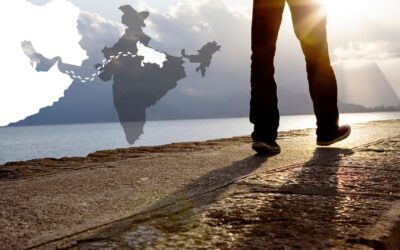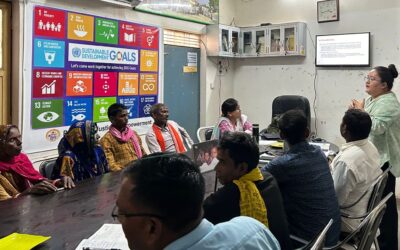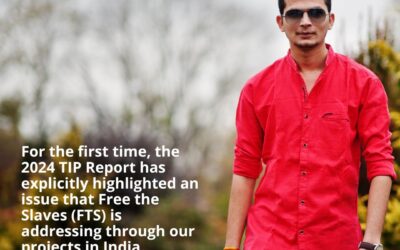During the 2010 Freedom Awards events, Free the Slaves became acquainted with an energetic artist and traveler, Ben Swatez. Ben did live painting during the Freedom Rocks after party, and we were inspired by his passion, and ability to connect with the audience.
Ben had an idea to continue to help Free the Slaves out: the India Art Project, which is an outgrowth of Free the Slaves’ Free a Village Build a Movement campaign, in which entire communities are brought out of slavery through holistic, economic and social programs. Ben auctioned off the art he produced at Freedom Rocks to finance his trip to India. There, he planned to create an art therapy program for survivors of slavery. In collaboration with the villagers, Ben planned to create a series of art works.
Read: In India: Systematic Food Theft From Population Most Vulnerable to Slavery
Ben successfully raised the money. Last month, he and his partner Diana departed for Uttar Pradesh, India, to work with the children in the village of Bahari—a village that was once embroiled in slavery, and now, with the help of FTS partners and the Free a Village Build a Movement campaign, have moved out of slavery.
Read Ben and Diana’s dispatch, and see more photos of children in Bahari doing art therapy after the jump!
Dearest friends,
Through the tools of creative expression we explored the heart of freedom with the extraordinary people of Bahari. Time once again took a mind of its own as lifetimes of learning passed with each day. Three weeks flew by in light and love.
We presented our final project to the villagers four days before our goodbye. This would be their opportunity to share their voice of freedom with the western world. We were overjoyed to welcome every single villager to class on the first day. From the earliest age that could hold a brush to those with wisdom in their wrinkles, all were present, desiring for their story to be heard through paint.
Let it begin!
On the first day, we asked the villagers to lay the background using colors of their choosing. A whirlwind of colors flew freely, with no one holding back. Stripes and bold lines, water marks and splotches marked the canvases with freedom. It was an incredibly successful first day.
We were full of anticipation on the second day when we asked the community to paint a wash over their background in order to create a pastel effect. This would allow for greater contrast when their individual expression was painted over the top of the background on the final day. When a community volunteer took the brush from one of the grandmothers and, with good intentions, painted circles on her canvas, we were concerned. Without a translator that day, it was difficult to impart our intentions for these pieces to be entirely unique to the artist. Moments later our hopes fell further as the entire community began painting circles on their composition as well. Admittedly, we were discouraged by this repetition as it directly conflicted with our western notion of freedom being synonymous with individuality. Even so, we maintained positive energy and an air of encouragement as the people shared their circled compositions with great pride in their eyes. It was important for us to continue creating a safe and loving environment despite the conflict with our preconceived notion of the freedom of expression. In these moments we realized that whether it be a wash, circles or painting a background, any guidance at all is a form of control. However, we believe that everything happens for a reason and trusted that this reason would reveal itself soon enough.
On the third day we presented the villagers with individual palettes of all colours and three new brushes of assorted sizes. As best we could, we expressed to the outsiders that no one is to assist the artists in any way, beyond helping get new paints and water. The only instruction was that there were no instruction. We were excited to witness the individual expression come alive atop the circles. The children exploded with wild brush strokes. Each painting came alive as they drew sunshine rays, flowers, large-eyed faces and other interesting shapes. No holds barred. They were off and running, painting freely and loving it. As for the adults, we were anxious to see what they individually came to share on canvas. Now that we had sufficiently set the stage for individuality, we anticipated just that. However, the adults once again began painting the very same image -a man, arms spread wide. We learned that this man was in fact a scarecrow. They were painting scarecrows. All of them. It was astonishing for us to witness and powerful for us to analyze the possible reasons for their choice. Agriculture is their lifeblood, the very core of their subsistence. The scarecrow protects their land and their livelihood. Another interpretation is that during their time of enslavement, the scarecrow was the only representation of a protective, non-threatening human presence.
We also came to see with the likeness of their work was not necessarily a depiction of their suppression but rather a indication that they think and act as a unit. These people have been enslaved together, they found freedom together, they are building their houses together and now they are painting together. As well, they have been consciously guided by Free the Slaves’ partners that their unity is their power. Beautiful. We began to look at their compositions with entirely new eyes. We began to see beyond the scarecrow icon itself to the details of their work. One woman drew the outline of her hand with palmistry lines indicating that she is in control of her destiny and with fingertips extended out toward the word ‘lotus’ in Hindi. The lotus flower is the Indian national flower and blossoms with roots embedded in the mud. Another woman drew her home with rainbow bricks surrounding a large white square of hope. The work was truly stunning and very unique in its detail.
The value of the insights we are bringing home with us is incalculable. This project has provided a unique opportunity to dive into the human psyche and explore the various manifestations of what it means to be free. Bahari has shown us the tremendous strength and beauty of unity.
Please see the attached photos for some of the people at work as well as the final pieces revealed
Much love and joy to you all. Looking forward to seeing you soon,
Benjamin and Diana




